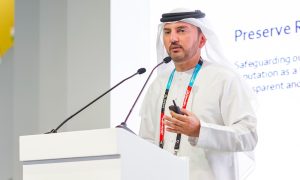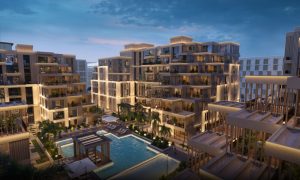Site visit: Dubai theme parks project right on track
Big Project ME takes a tour around the massive Dubai Parks and Resorts site – home of three of the region’s most exciting theme park projects.

The scenery along the Dubai – Abu Dhabi highway has never been very exciting, with featureless mounds of sand and the occasional shrub the only things to catch the eye. The only indication that one is entering or leaving one of the region’s most dynamic cities is the vast industrial heartland of Jebel Ali.
All that is about to change over the next two years. As keen-eyed motorists might notice, there is a huge swathe of construction hoardings running along the highway, hiding one of Dubai’s most intriguing construction projects.
Last November, Dubai Parks and Resorts, a subsidiary of Meraas Holding, announced that it has achieved 35% completion of its preliminary infrastructure work across its $2.72 billion multi-themed leisure and entertainment project. It also announced that, in parallel with the infrastructure works, civil works had commenced.
Meanwhile, more than 50% of the construction contracts have been procured, with 45% of utility services complete, according to Dubai Parks and Resorts. With excavation work for the district cooling facility also seeing significant progress, the project is well underway and looking to hit its scheduled completion date in the third quarter of 2016.
Launched under the directive of His Highness Sheikh Mohammed Bin Rashid Al Maktoum, the Vice-President and Prime Minister of the UAE and Ruler of Dubai, the Dubai Parks and Resorts project aims to become one of the premier tourist attractions in a city built for tourism.
Using the likes of Universal Studios and Disneyland as inspiration, the developers behind the Dubai parks are building three theme parks in the area – Motiongate Dubai, Legoland Dubai and Bollywood Parks. A four-star resort, Lapita Hotel, will also be built, along with Riverpark – a complementary retail, dining and entertainment district that will connect the three parks and the hotel. Part of Dubai’s Tourism Vision 2020, the parks aim to help achieve annual visitor numbers of 20 million a year in 2020, while increasing the economic contribution of the tourism sector.
“We chose Dubai because of the push for tourism. This is a city built for tourism,” says Brian Machamer, senior director – Theme Park Operations at Dubai Parks and Resorts. “Between the three parks, there will be tiered pricing, I know that for a fact. We’ll have packaging with hotels [in the city]. Of course, if you go to more than one park, you’ll get discounts. Riverpark will be a destination of its own, with tourists and locals coming out for both retail and dining,” he tells Big Project ME during a media tour of the gargantuan site.
“Movie theme parks always do well. Universal has a couple of Dreamworks attractions, they have a 4D theatre in Singapore and they have one in Orlando as well. But this is the first time that Dreamworks have done anything with the movies How to Train Your Dragon and Kung Fu Panda, at least to this extent. We’re working with the writers of those films – both have new films coming out, and we’re working with them to introduce new characters and storylines, so that when the park opens it’ll be very current with the franchises.”
The project covers a total area of 2,322,576sqm; an initial area of 1.48 million sqm will be developed, with access roads and parking taking up an additional 836,127sqm of land.
“What we’ve put together is a good product offering. It’s not over the top. The whole plot for Motiongate is 371,612sqm; we’re only developing 185,806sqm for opening day. All three parks have expansion area. For each of them, we’re developing maybe half of the plot so that it allows for that expansion. In the old days they would have built up the whole area, so it’s a very practical approach,” Machamer asserts.
With the first phase of the project scheduled to be completed in just over two years, it is probably for the best that the team stays prudent. With the procurement of the majority of the planned rides in place, Paul La France, chief projects officer at Dubai Parks and Resorts, says that a new phase of development is now underway.
“Following a stringent bidding process, we have chosen some of the world’s leading players in the entertainment rides industry. Several of the attractions are world-firsts in terms of integrating best-in-class technology and expertise,” he says.
“Utilities are 40% complete, as well as 40% of network infrastructure. The design of the access road network is just about done, and will go out for tender [in January 2015]. It’s going to be ready for opening day. There will be three lanes going to Dubai and three lanes going to Abu Dhabi.
“We have a sewage treatment plant, which is actually a temporary one; the real connection won’t be available for a number of years, so we’re using this one,” he says. “The substation will be done by July next year, it’s a big one and it’ll have the district cooling plant right behind it. That’s really key for us because, unlike the rest of the construction projects in Dubai, we have to test and adjust the rides. For that you need to have permanent power and you can’t use generators.”
He adds that a Dubai Metro station will be built by 2018, keeping in mind the planned expansion of the metro network by the RTA. This close cooperation with the government authorities also extends to the planning of the roads and public transport systems, La France points out.
“[The road work] is being funded by Dubai Parks and Resorts; we’ve initiated the design, but it will be under the control of the RTA. The Metro station won’t open till 2018 as it’s really geared towards the Expo 2020 as well. It’s in the future, but it has been planned for and there are provisions for it.”
In its first year of operations in 2017, Dubai Parks and Resorts is expected to attract 6.7 million visitors, with significant growth expected over the following four-year period.
A number of high-calibre contractors and consultants have been engaged on the projects, with the likes of Samsung C&T, Hill International, ARCO General Contracting, Laing O’Rourke, Forrec, Cumming and Gensler all involved in some capacity. These companies are currently overseeing a workforce of more than 2,500 people. Once the construction schedule hits its peak at the end of 2015, Dubai Parks and Resorts estimates that 6,500 people will be working on the megaproject.
“We’ve had no lost-time accidents so far. There’s a system in place and so far, so good. Peak construction is going to be in May 2015 and we’ll have to respect the laws of Dubai [with regard to summer work hours]. So between the hours of 12pm and 4pm, we won’t work. We respected that last year, we’ll respect it this year. It is what it is, you have to follow the rules. Right now, we only have a 24/7 cycle where it’s critical. If the project gets behind schedule, it’ll be 24/7 till we catch up. But of course, during the summer, we’ll follow the rules,” La France asserts.
“60% of our team are from international theme parks – both from Disney and Universal. They all come from that business. The other part of the team is Dubai-based. So it’s a blend. You have to have local knowledge on a project like this,” he adds.
As a result, the tendering process for the theme parks has been quite stringent, he says, pointing out that prior experience has been necessary in some cases. “The general contractors, some of them have experience in theme parks, but when you’re looking at the facades and theming, all that stuff – it is speciality stuff. There’s about eight or nine subcontractors who can do that work and they’re from all over the world, and from here as well, so they’re all nominated [for the main contractor to use].”
“We’re tendering right now for the rest of the facility contracts – we should have awarded all our facility contracts by the end of 2014. 95% of the rides have been purchased from the vendors, so we’re okay there. What’s out to tender is the main package for the hotel, the main package for the river park and then a medium-sized package for Bollywood Park. Legoland has all been tendered,” La France says.
With above-ground work scheduled to start next year, and infrastructure and utilities work well underway, the project team had to ensure that the terrain on the site was prepared for operations.
“It looks flat now,” says La France, “but it wasn’t flat. Yes, digging in sand was and is easier than digging in clay or mud, but we had to have piles in a few buildings – the Dreamworks building, the ‘Raj Mahal’ – for example. [However], most of them didn’t have piles because they’re lightweight structures. The soil is good here and the water table is about 20 feet down, so we didn’t have too many problems,” he adds as the media tour wraps up. “We have a great team that is overseeing the progress of this project, and we’ve made significant headway in all construction areas. It’s on budget and on schedule. I’ve been doing this for a long time, and I’m confident that we’ll do it!”





